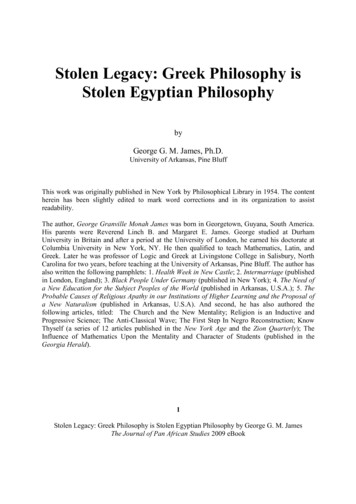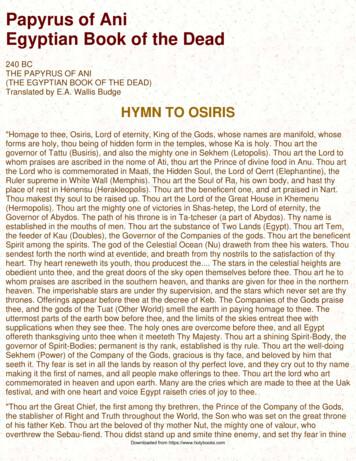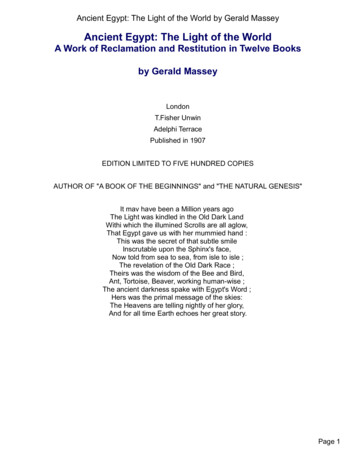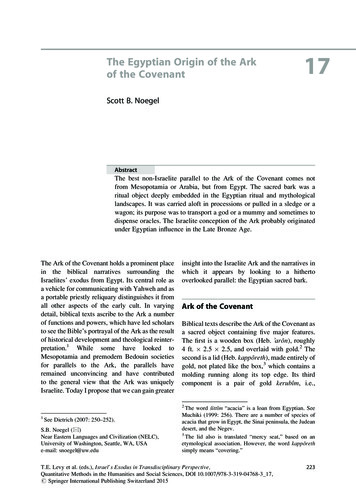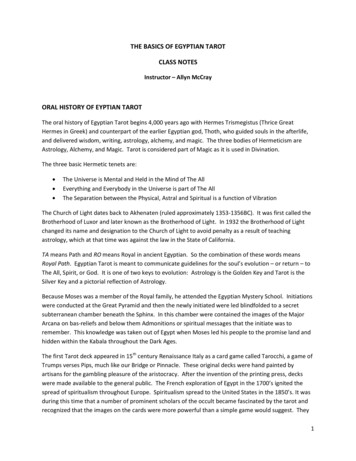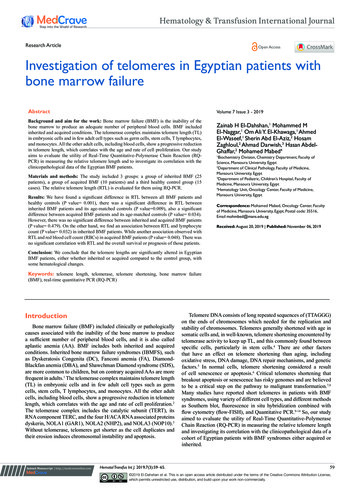
Transcription
Hematology & Transfusion International JournalResearch ArticleOpen AccessInvestigation of telomeres in Egyptian patients withbone marrow failureAbstractVolume 7 Issue 3 - 2019Background and aim for the work: Bone marrow failure (BMF) is the inability of thebone marrow to produce an adequate number of peripheral blood cells. BMF includedinherited and acquired conditions. The telomerase complex maintains telomere length (TL)in embryonic cells and in few adult cell types such as germ cells, stem cells, T lymphocytes,and monocytes. All the other adult cells, including blood cells, show a progressive reductionin telomere length, which correlates with the age and rate of cell proliferation. Our studyaims to evaluate the utility of Real-Time Quantitative-Polymerase Chain Reaction (RQPCR) in measuring the relative telomere length and to investigate its correlation with theclinicopathological data of the Egyptian BMF patients.Materials and methods: The study included 3 groups: a group of inherited BMF (25patients), a group of acquired BMF (10 patients) and a third healthy control group (15cases). The relative telomere length (RTL) is evaluated for them using RQ-PCR.Results: We have found a significant difference in RTL between all BMF patients andhealthy controls (P value 0.001), there was a significant difference in RTL betweeninherited BMF patients and its age-matched controls (P value 0.009), also a significantdifference between acquired BMF patients and its age-matched controls (P value 0.034).However, there was no significant difference between inherited and acquired BMF patients(P value 0.479). On the other hand, we find an association between RTL and lymphocytecount (P value 0.032) in inherited BMF patients. While another association observed withRTL and red blood cell count (RBCs) in acquired BMF patients (P value 0.048). There wasno significant correlation with RTL and the overall survival or prognosis of those patients.Zainab H El-Dahshan,1 Mohammed MEl-Naggar,1 Om Ali Y. El-Khawaga,1 AhmedEl-Waseef,1 Sherin Abd El-Aziz,2 HosamZaghloul,2 Ahmad Darwish,3 Hasan AbdelGhaffar,2 Mohamed Mabed4Biochemistry Division, Chemistry Department, Faculty ofScience, Mansoura University, Egypt2Department of Clinical Pathology, Faculty of Medicine,Mansoura University, Egypt3Department of Pediatric, Children’s Hospital, Faculty ofMedicine, Mansoura University, Egypt4Hematology Unit, Oncology Center, Faculty of Medicine,Mansoura University, Egypt1Correspondence: Mohamed Mabed, Oncology Center, Facultyof Medicine, Mansoura University, Egypt, Postal code: 35516,EmailReceived: August 20, 2019 Published: November 06, 2019Conclusion: We conclude that the telomere lengths are significantly altered in EgyptianBMF patients, either whether inherited or acquired compared to the control group, withsome hematological changes.Keywords: telomere length, telomerase, telomere shortening, bone marrow failure(BMF), real-time quantitative PCR (RQ-PCR)IntroductionBone marrow failure (BMF) included clinically or pathologicallycauses associated with the inability of the bone marrow to producea sufficient number of peripheral blood cells, and it is also calledaplastic anemia (AA). BMF includes both inherited and acquiredconditions. Inherited bone marrow failure syndromes (IBMFS), suchas Dyskeratosis Congenita (DC), Fanconi anemia (FA), DiamondBlackfan anemia (DBA), and Shawchman Diamond syndrome (SDS),are more common to children, but on contrary acquired AAs are morefrequent in adults.1 The telomerase complex maintains telomere length(TL) in embryonic cells and in few adult cell types such as germcells, stem cells, T lymphocytes, and monocytes. All the other adultcells, including blood cells, show a progressive reduction in telomerelength, which correlates with the age and rate of cell proliferation.2The telomerase complex includes the catalytic subunit (TERT), itsRNA component TERC, and the four H/ACA RNA associated proteinsdyskerin, NOLA1 (GAR1), NOLA2 (NHP2), and NOLA3 (NOP10).3Without telomerase, telomeres get shorter as the cell duplicates andtheir erosion induces chromosomal instability and apoptosis.Submit Manuscript http://medcraveonline.comHematol Transfus Int J. 2019;7(3):59‒65.Telomere DNA consists of long repeated sequences of (TTAGGG)on the ends of chromosomes which needed for the replication andstability of chromosomes. Telomeres generally shortened with age insomatic cells and, in well-known, telomere shortening encountered bytelomerase activity to keep up TL, and this commonly found betweenspecific cells, particularly in stem cells.4 There are other factorsthat have an effect on telomere shortening than aging, includingoxidative stress, DNA damage, DNA repair mechanisms, and geneticfactors.5 In normal cells, telomere shortening considered a resultof cell senescence or apoptosis.6 Critical telomeres shortening thatbreakout apoptosis or senescence has risky genomes and are believedto be a critical step on the pathway to malignant transformation.7,8Many studies have reported short telomeres in patients with BMFsyndromes, using variety of different cell types, and different methodsas Southern blot, fluorescence in situ hybridization combined withflow cytometry (flow-FISH), and Quantitative PCR.9-14 So, our studyaimed to evaluate the utility of Real-Time Quantitative-PolymeraseChain Reaction (RQ-PCR) in measuring the relative telomere lengthand investigating its correlation with the clinicopathological data of acohort of Egyptian patients with BMF syndromes either acquired orinherited.59 2019 El-Dahshan et al. This is an open access article distributed under the terms of the Creative Commons Attribution License,which permits unrestricted use, distribution, and build upon your work non-commercially.
Copyright: 2019 El-Dahshan et al.Investigation of telomeres in Egyptian patients with bone marrow failureSubjects and methodsSubjectsThis study included 3 groups (50 individuals): 25 patients asinherited BMF group, 10 patients with pure red blood cell aplasia60(PRBCA), 15 patients with Fanconi anemia (FA), while 10 patientsin acquired BMF group as acquired aplastic anemia (AAA) and15 normal individuals as a third group 10 as age-matched healthyindividuals for inherited BMF group (ranges from 3 to 17 years old)and 5 as age-matched individuals for acquired BMF group (rangesfrom 21-70 years old). Patient characteristics are shown in Table 1.Table 1 Demographic, laboratory data and Patient characteristics.NControl groupInherited BMFpatientsAcquired BMFpatients152910SEXM/F09-Jun16/1305-MayAGEMedian (Range)35 (3-70)6 (1-16)34 (21-70)HB(g/dL)Median (Range)12.1 (10.0-14.30)7.29 (3.92-11.10)7.75 (4.18-9.41)RBCs(x1012/L)Median (Range)5.0 (4.47-5.54)2.54 (1.49-5.12)2.83 (1.90-4.18)WBCs(x109/L)Median (Range)6.50 (5.50-7.10)5.56 (0.99-32.80)3.56 (1.14-4.83)LYM%Median (Range)63.0 (34.20-76.50)44.5 (15.20-75.20)63.0 (29.60-76.50)NEUT%Median (Range)50.0 (40.0-55.0)35.90 (10.0-79.60)27.10 (18.6-69.0)PLTs (x 109/L)Median (Range)195.0(190.0-313.0)166.0 (4.30-1179.0)28.1 (11.10-371.0)BMF, bone marrow failure; HB, hemoglobin; RBCs, red blood cells; WBCs. white blood cells; PLTs, platelets; LYM, lymphocytesBMF patients were diagnosed based on complete blood countand bone marrow aspiration and biopsy examination. Patients withinherited BMF syndromes included pure red blood cell aplasia(PRBCA) and Fanconi anemia (FA), these two syndromes werediagnosed according to clinical criteria, including specific congenitalanomalies and syndrome-specific laboratory tests;15 chromosomebreakage analysis for FA, and red cell adenosine (ADA) for PRBCA.Acquired BMF patients were diagnosed according to the presenceof the bone marrow hypo cellular without congenital anomalies andnegative results of chromosomal breakage analysis.Inherited BMF patients followed a protocol of treatment forandrogens and corticosteroids; most of them were blood transfusiondependent. Four patients that received a successful bone marrowtransplant (BMT) showed slightly improved levels of hematologyparameters. Patients with acquired BMF were treated with cyclosporinA (CsA). Also, most of them were blood transfusion dependent.Patients were recruited from the hematology outpatient clinic atChildren Hospital (MUCH) for children and for adults at OncologyCentre Mansoura University (OCMU), Mansoura, Egypt. Writteninformed consent was obtained from all participants. This study wasapproved by the Human Ethics Committee of the Mansoura Universityin accordance with the Declaration of Helsinki.Measurement of Telomere by RQ-PCRGenomic DNA extracted from 200 µL of peripheral blood usingGene JETTM Genomic DNA Purification Kit (Fermentas spincolumns, Canada).Extracted DNA carried on different occasions. Therelative average of telomere length (RTL) determined by RQ-PCR asdescribed by Cawthon16 with some changes. For each DNA sample,telomere (T) and single copy gene (S) master mixes prepared andran on Applied Biosystems StepOne (Applied Biosystems, FosterCity, CA, USA). The reaction mixture was in a final volume of 30µL containing 12 µL SYBR Green master mix (Applied Biosystems,Warrington, UK, 4344464) and 35ng of DNA, these also included thefinal concentrations for telomere primer 270nM for tel1; and 900nMfor tel2, and 300nM for 36B4u; and 500nM for 36B4d (single copygene). The 36B4 gene encodes acidic ribosomal phosphoprotein PO,is on chromosome 12,17 (written, (Table 2) were:Table 2 Primer sequences for quantitative real-time PCR.Primer sequences(5 3)NameTelomere36B4Forwardtel1, GGTTTTTGAGGGTGAGGGTGAGGGTGAGGGTGAGGGTReversetel2, u, CAGCAAGTGGGAAGGTGTAATCCReverse36B4d, CCCATTCTATCATCAACGGGTACAACitation: El-Dahshan ZH, El-Naggar MM, El-Khawaga OAY, et al. Investigation of telomeres in Egyptian patients with bone marrow failure. Hematol Transfus Int J.2019;7(3):59‒65. DOI: 10.15406/htij.2019.07.00206
Copyright: 2019 El-Dahshan et al.Investigation of telomeres in Egyptian patients with bone marrow failureEach run involved two 96-well plates prepared for each assay,one containing telomere primers and the other 36B4 primers usedas a single copy gene. A standard DNA (Applied Biosystems, FosterCity, CA, 350436) was serially diluted by ̴ 1.68-fold per dilution toproduce five concentrations of DNA, ranging from 0.63ng to 5ng/µLto produce standard curves one for telomere repeats and the other for36B4 gene. Then, efficiency calculated by using the formula E 10[-1/slope] - 1. The slope values for the telomere and 36B4 assays inthe current study were ̶ 3.289 and ̶ 3.314 respectively; generatingefficiencies equals 99% (recommended range 90-110%). All samplesanalyzed in triplicates. Amplification was carried out at 95 C for 10min followed by for telomere primer, 18 cycles at 95 C for 15 s, 54 Cfor 2 min. For 36B4 primer followed by 30 cycles at 95 C for 15 s,58 C for 1 min. Telomere/Single-copy gene (T/S) ratio values werethen calculated using the formula for comparative method T/S 2 –ΔΔCT for relative quantification. T/S ratios for each sample obtainedby dividing the mean amount of telomeres by the mean amount of36B4.Statistical Analysis: Statistical analysis performed with SPSSversion 16.0. Non-parametric tests were used. Median and Rangecalculated for telomere length. Mann-Whitney Rank Sum test is anon-parametric test used to compare two populations’ means thatcome from the same population. The Kruskal-Wallis H test used tocompare between two or more groups. The Kendall rank correlationcoefficient used to assess the association of T/S ratio measurementswith the study variables. Receiver s Operating Characteristics (ROC)curve analysis used to get the area under the curve (AUC) to decidethe diagnostic power of RTL in BMF patients either inherited oracquired. Statistical significance was considered when P 0.05.ResultsA total 35 patients with BMF and 15 individuals as healthyage-matched control group were included in this study. RTL was61significantly lower in all patients with BMF (Median: -2.30, range:-5.33 to -0.09) than that of all age-matched controls (Median: -1.37,range: -1.74 to -1.01), (P 0.001). Meanwhile, there was a significantdifference between inherited BMF patients (Median: -2.30, range:-4.49 to -0.09) and its age-matched controls (Median: -1.53, range:-1.74 to -1.01), (P 0.009). Also, there was a significant differencebetween acquired BMF patients (Median: -1.82, range: -5.33 to-0.49) and their controls (Median: -1.30, range: -1.60 to -1.01), (P 0.034). On the other hand, there was no significant difference in bothinherited (Median: -2.30, range: -4.49 to -0.09) and acquired BMFpatients (Median: -1.82, range: -5.33 to -0.49), (P 0.479). Therewas no significant difference in RTLs between different subtypes ofinherited BMF patients (n 29, P 0. 267) (Table 3).From the ROC curve analysis, the supposed optimal cut-offvalue is 0.032 (for discriminating RTL in all BMF patients fromall controls), which yielded a sensitivity of 0.769, a specificity of0.600 (1-specificity 0.400) and the AUC is 0.790 (95% CI: 0.667to 0.912) (Figure 1). While, the supposed optimal cut-off value is0.014 (for discriminating RTL in the inherited BMF patients from theacquired), which yielded a sensitivity of 0.600, a specificity of 0.759(1-specificity 0.241), and the AUC is 0.576 (95% CI: 0.359 to 793)(Figure 2).TL has a significant correlation with red blood cells countin acquired BMF patients (P 0.048, Figure 3); however, it has asignificant correlation with the lymphocytes in the inherited BMFpatients (P 0.032, Figure 4). We observed that there was noassociation between RTL and patient’s situation at last contact neitherin acquired BMF patients (r 0.031, P 0.815), nor in inherited BMFpatients (r 0.091, P 0.583). Also, there was no association betweenRTL and overall survival from diagnosis neither in acquired BMFpatients (r 0.090, P 0.719) nor in inherited BMF patients (r 0.151,P 0.287) (Table 4).Table 3 Telomere length comparison in different study groupsAll BMF patients (n 39) vs. Healthy controls (n 15)Log RTL medianRangeP-value-2.30vs. -1.37-5.33: -0.090.001***-1.74: -1.01Inherited BMF patients (n 29) vs. age-matched controls (n 10)-2.30vs. -1.53-4.49: -0.090.009**-1.74: -1.01Acquired BMF patients(n 10) vs. age-matched controls (n 5)-1.82vs.-1.30-5.33: -0.490.034*-1.60: -1.01Inherited (n 29) vs. Acquired (n 10)BMF patients-2.30vs.-1.82-4.49: -0.090.479-5.33: -0.49BMF, bone marrow failure; Log RTL: logarithm transformation of 2 –ΔΔ of relative telomere length.18 Mann-Whitney U test was used. The significance level was *p 0.05, ** p 0.01 or *** p 0.001.Citation: El-Dahshan ZH, El-Naggar MM, El-Khawaga OAY, et al. Investigation of telomeres in Egyptian patients with bone marrow failure. Hematol Transfus Int J.2019;7(3):59‒65. DOI: 10.15406/htij.2019.07.00206
Copyright: 2019 El-Dahshan et al.Investigation of telomeres in Egyptian patients with bone marrow failure62Figure 1 Receiver operating characteristic (ROC) curve analysis shows the relative telomere length (RTL) in all BMF patients with all healthy controls: Thesupposed optimal cutoff value of RTL is 0.032 used as a marker for discriminating BMF patients from healthy controls.Figure 2 Receiver operating characteristic (ROC) curve analysis shows the relative telomere length (RTL) in inherited and acquired BMF patents: The supposedoptimal cutoff value of RTL is 0.014 used as a marker for discriminating inherited BMF group from the acquired.Table 4 Correlations of Relative Telomere Length (RTL) in BMF patients with their clinicopathological Acquired BMF patientsn .3660.173-0.3660.1730.0310.8150.090.719Inherited BMF patientsn F, bone marrow failure; HB, hemoglobin; RBCs, red blood cells;WBCs, white blood cells; PCS, patient’s current situations and OAS: overall survival.The Kendallrank correlation coefficient was used where appropriate. The significance level was * p 0.05, ** p 0.01 or *** p 0.001.Citation: El-Dahshan ZH, El-Naggar MM, El-Khawaga OAY, et al. Investigation of telomeres in Egyptian patients with bone marrow failure. Hematol Transfus Int J.2019;7(3):59‒65. DOI: 10.15406/htij.2019.07.00206
Investigation of telomeres in Egyptian patients with bone marrow failureDiscussionIt is worth mentioning that we are in Egypt in the Middle East area,there is a difference in lengths of telomeres. To evaluate the differencesin the TL on multi-ethnic groups, non-Hispanic Whites were found tohave shorter TL compared to Caucasians,19 African Americans,20 andHispanics.5,21 Whilst, another study suggested that African Americansand Hispanics have a shorter TL than Non-Hispanic Whites.22 Otherfactors confirmed a relationship between telomere repeats in certainmulti-ethnic groups as socioeconomic and psychosocial factors whichled to variation in telomere shortening,22 namely education degree23and perceived strain.24Racism can contribute to being a part of racial variations in TL,25where, the TL is longer in blacks than whites, telomere shortening,is also significantly greater in blacks where they become more agingthan whites suggesting health disparities.25 Heritability of TL has beensaid as an opportunity attention in racial variations.7 A third studyproposed the weathering hypothesis with exposure to chronic stressmake contributions to expand telomere shortening, which also causesracial variations.27In our study, TLs in BMF patients were compared to the TLs in thehealthy controls observing that BMF patients have shorter telomeres(Table 3). ROC curve analysis showed the diagnostic value of RTLand succeeded to discriminate between BMF patients and healthycontrols (Figure 1), but it failed to discriminate RTL between theinherited and acquired BMF patients showing similarities in TL withindifferent subtypes of disease (Figure 2). Our findings are similar toBall and colleagues and Pavesi and colleagues9,12 who reported thatBMF patients have shorter telomeres than that of controls and thereCopyright: 2019 El-Dahshan et al.63is no significant difference in TL either inherited or acquired BMFconditions.The role of TL in BMF patients and its correlation with theclinicopathological data have not yet been delineated. To the best ofour knowledge, this is the first time to observe that there is a positivecorrelation between relative telomere length and red blood cells countreduction in acquired BMF patients (Table 4) (Figure 3). This couldbe due to that most patients are blood transfusion-dependent, whereshort telomeres in nucleated RBC progenitors leading to promotetelomerase activity by erythropoietin to increase RBCs production.29On the other hand, the findings observed by Ball and colleagues;9which applied to acquired aplastic anemia patients using the Southernblot method, they found that there was no correlation betweentelomere shortening and recovery of blood elements.On the other hand, an inverse correlation observed betweenthe lymphocytes count and telomere shortening in inherited BMFpatients (Table 4) (Figure 4). This could be explained by the factthat the purified candidate stem cells show asymmetric cell divisionsin vivo and variations in the replicative history between individualstem cells seem to show the proliferation capacity on the level ofmultipotent hematopoietic stem cells where telomerase enzyme ispresent to encounter telomere shortening.30 Meanwhile, a study byBrümmendorf and colleagues31 found that there was no correlationbetween telomere shortening and lymphocytes count in patientswith aplastic anemia using the flow-FISH method. Moreover, Alterand colleagues32 showed that telomere shortening in lymphocytesassociated with severity of BMF in patients with DC, while our studydoes not include DC.Figure 3 The Kendall s rank correlation coefficient shows the correlation between the Relative Telomere Length (RTL) and Red Blood Cells (RBCs) Count inAcquired Bone Marrow Failure (ABMF) patients: A scatter Plot Shows positive correlation between RTL and RBCs Count (r 0.494, P 0.05).Citation: El-Dahshan ZH, El-Naggar MM, El-Khawaga OAY, et al. Investigation of telomeres in Egyptian patients with bone marrow failure. Hematol Transfus Int J.2019;7(3):59‒65. DOI: 10.15406/htij.2019.07.00206
Investigation of telomeres in Egyptian patients with bone marrow failureCopyright: 2019 El-Dahshan et al.64Figure 4 The Kendall s rank correlation coefficient shows the correlation between the Relative Telomere Length (RTL) and Lymphocytes Count in InheritedBone Marrow Failure patients (IBMF): A scatter plot shows a negative correlation between RTL and Lymphocytes (r -0.339, P 0.05).ConclusionTelomere length is significantly altered in Egyptian patients withBMF syndromes, whether being inherited or acquired compared totheir age-matched controls. We found an inverse correlation betweentelomere shortening and lymphocytes count in inherited BMFpatients, while the telomere length has a positive correlation with redblood cells count in acquired BMF patients. Meanwhile, the degreeof telomere shortening does not have relation to patient’s prognosisor overall survival.AcknowledgmentsNone.Conflicts of interestThe author declares no conflicts of interest.FundingNone.References1. Savage SA, Alter BP. The role of telomere biology in bone marrowfailure and other disorders. Mechanisms of ageing and development.2008;129(1):35–47.2. Lansdorp PM. Telomeres, stem cells, and hematology. Blood.2008;111(4):1759–1766.3. Calado RT, Young NS. Telomere diseases. New England Journal ofMedicine. 2009;361(24): 2353-2365.4. Cheung A, Deng W. Telomere dysfunction, genome instability andcancer. Front Biosci. 2008;13(1): 2075–2090. 27415. Sanders JL, Newman AB. Telomere length in epidemiology: a biomarkerof aging, age-related disease, both, or neither? Epidemiologic reviews.2013;35(1):112–131.6. Palm W, de Lange T. How shelterin protects mammalian telomeres.Annual review of genetics. 2008;42: 301–334.7. Koorstra JB, Hustinx SR, Offerhaus GJ, et al. Pancreatic Carcinogenesis.Pancreatology. 2008;8(2):110–125.8. Cunningham JM, 22Johnson%20RA”Johnson RA, 22Litzelman%20K”Litzelman K, et al. Telomere length varies by DNA extraction method:implications for epidemiologic research. Cancer Epidemiol BiomarkersPrev. 2013;22(11):2047–2054.9. Ball SE, 22Gibson%20FM”Gibson FM, 22Rizzo%20S”Rizzo S,et al. Progressive telomere shortening in aplastic anemia. Blood.1998;91(10):3582–3592.10. Leteurtre F, Li X, Guardiola P, et al. Accelerated telomere shorteningand telomerase activation in Fanconi’s anaemia. British journal ofhaematology. 1999;105(4):883–893.11. Thornley I, Dror Y, Sung L, et al. Abnormal telomere shortening inleucocytes of children with Shwachman–Diamond syndrome. Br JHaematol. 2002;117(1):189–192.12. Pavesi E, Avondo F, Aspesi A, et al. Analysis of telomeres in peripheralblood cells from patients with bone marrow failure. Pediatric blood andcancer. 2009;53(3):411–416.13. Du HY, Pumbo E, Ivanovich J, et al. TERC and TERT gene mutationsin patients with bone marrow failure and the significance of telomerelength measurements. Blood. 2009;113(2):309–316.14. Myers KC, Bolyard AA, Otto B, et al. Variable clinical presentationof Shwachman–Diamond syndrome: update from the North AmericanShwachman–Diamond syndrome registry. J Pediatr. 2014;164(4):866–870.Citation: El-Dahshan ZH, El-Naggar MM, El-Khawaga OAY, et al. Investigation of telomeres in Egyptian patients with bone marrow failure. Hematol Transfus Int J.2019;7(3):59‒65. DOI: 10.15406/htij.2019.07.00206
Investigation of telomeres in Egyptian patients with bone marrow failure15. Camitta BM, Thomas ED, Nathan DG, et al. Severe aplastic anemia: aprospective study of the effect of early marrow transplantation on acutemortality. Blood. 1976;48(1):63–70.16. Cawthon RM. Telomere measurement by quantitative PCR. Nucleicacids research. 2002;30(10):e47.17. Boulay J, Reuter J, Ritschard R, et al. Gene dosage by quantitative realtime PCR. Biotechniques. 1999;27(2):228.18. Kubista M, Andrade JM, Bengtsson M, et al. The real-time polymerasechain reaction. Mol Aspects Med. 2006;27(2):95–125.19. Zhu H, Wang X, Gutin B, et al. Leukocyte telomere length in healthyCaucasian and African-American adolescents: relationships withrace, sex, adiposity, adipokines, and physical activity. J Pediatr.2011;158(2):215–220.20. Shalev I, Entringer S, Wadhwa PD, et al. Stress and telomere biology:a lifespan perspective. Psychoneuroendocrinology. 2013;38(9):1835–1842.21. Lynch SM, Peek MK, Mitra N, et al. Race, ethnicity, psychosocialfactors, and telomere length in a multicenter setting. PloS one.2016;11(1):e0146723.22. Diez Roux AV, Ranjit N, Jenny NS, et al. Race/ethnicity and telomerelength in the Multi-Ethnic Study of Atherosclerosis. Aging cell.2009;8(3):251–257.23. Starkweather AR, Alhaeeri AA, Montpetit A, et al. An integrativereview of factors associated with telomere length and implications forbiobehavioral research. Nurs Res. 2014;63(1):36.24. Parks CG, Miller DB, McCanlies EC, et al. Telomere length, currentCopyright: 2019 El-Dahshan et al.65perceived stress, and urinary stress hormones in women. CancerEpidemiol Biomarkers Prev. 2009;18(2):551–560.25. Chae DH, Nuru-Jeter AM, Adler NE, et al. Discrimination, racialbias, and telomere length in African-American men. Am J Prev Med.2014;6(2):103–111.26. Rewak M, Buka S, Prescott J, et al. Race-related health disparities andbiological aging: does rate of telomere shortening differ across blacksand whites? Biol Psychol. 2014;99:92–99.27. Geronimus AT, Hicken M, Keene D, et al. Weathering and age patternsof allostatic load scores among blacks and whites in the United States.Am J Public Health. 2006;96(5):826–833.28. Aubert G, Hills M, Lansdorp PM. Telomere length measurement—Caveats and a critical assessment of the available technologies andtools. Mutation Research/Fundamental and Molecular Mechanisms ofMutagenesis. 2012;730(1):59–67.29. De Meyer T, De Buyzere ML, Langlois M, et al. Lower red blood cellcounts in middle-aged subjects with shorter peripheral blood leukocytetelomere length. Aging cell. 2008;7(5):700–705.30. Zhou J, Shen X, Huang J, et al. Telomere length of transferredlymphocytes correlates with in vivo persistence and tumor regressionin melanoma patients receiving cell transfer therapy. J Immunol.2005;175(10):7046–7052.31. Brümmendorf TH, Maciejewski JP, Mak J, et al. Telomere length inleukocyte subpopulations of patients with aplastic anemia. Blood.2001;97(4):895–900.32. Alter BP, Giri N, Savage SA, et al. Telomere length in inherited bonemarrow failure syndromes. Haematologica. 2015;100(1):9–54.Citation: El-Dahshan ZH, El-Naggar MM, El-Khawaga OAY, et al. Investigation of telomeres in Egyptian patients with bone marrow failure. Hematol Transfus Int J.2019;7(3):59‒65. DOI: 10.15406/htij.2019.07.00206
Centre Mansoura University (OCMU), Mansoura, Egypt. Written informed consent was obtained from all participants. This study was approved by the Human Ethics Committee of the Mansoura University in accordance with the Declaration of Helsinki. Measurement of Telomere by RQ-PCR Genomic DNA extracted from 200 µL of peripheral blood using

